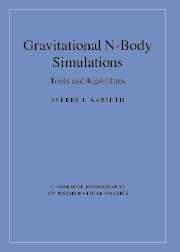Book contents
- Frontmatter
- Contents
- Preface
- 1 The N-body problem
- 2 Predictor–corrector methods
- 3 Neighbour treatments
- 4 Two-body regularization
- 5 Multiple regularization
- 6 Tree codes
- 7 Program organization
- 8 Initial setup
- 9 Decision-making
- 10 Neighbour schemes
- 11 Two-body algorithms
- 12 Chain procedures
- 13 Accuracy and performance
- 14 Practical aspects
- 15 Star clusters
- 16 Galaxies
- 17 Planetary systems
- 18 Small-N experiments
- Appendix A Global regularization algorithms
- Appendix B Chain algorithms
- Appendix C Higher-order systems
- Appendix D Practical algorithms
- Appendix E KS procedures with GRAPE
- Appendix F Alternative simulation method
- Appendix G Table of symbols
- Appendix H Hermite integration method
- References
- Index
2 - Predictor–corrector methods
Published online by Cambridge University Press: 18 August 2009
- Frontmatter
- Contents
- Preface
- 1 The N-body problem
- 2 Predictor–corrector methods
- 3 Neighbour treatments
- 4 Two-body regularization
- 5 Multiple regularization
- 6 Tree codes
- 7 Program organization
- 8 Initial setup
- 9 Decision-making
- 10 Neighbour schemes
- 11 Two-body algorithms
- 12 Chain procedures
- 13 Accuracy and performance
- 14 Practical aspects
- 15 Star clusters
- 16 Galaxies
- 17 Planetary systems
- 18 Small-N experiments
- Appendix A Global regularization algorithms
- Appendix B Chain algorithms
- Appendix C Higher-order systems
- Appendix D Practical algorithms
- Appendix E KS procedures with GRAPE
- Appendix F Alternative simulation method
- Appendix G Table of symbols
- Appendix H Hermite integration method
- References
- Index
Summary
Introduction
In this chapter, we provide the tools needed for standard N-body integration. We first review the traditional polynomial method which leads to increased efficiency when used in connection with individual time-steps. This self-contained treatment follows closely an earlier description [Aarseth, 1985a, 1994]. Some alternative formulations are discussed briefly for completeness. We then introduce the simpler Hermite scheme [Makino, 1991a,b] that was originally developed for special-purpose computers but is equally suitable for workstations or laptops and is attractive by its simplicity. As discussed in a later section, the success of this scheme is based on the novel concept of using quantized time-steps (factor of 2 commensurate), which reduces overheads. Variants of the Hermite method were attempted in the past, such as the low-order scheme of categories [Hayli, 1967, 1974] and the full use of explicit Taylor series derivatives [Lecar, Loeser & Cherniack, 1974]. The former study actually introduced the idea of hierarchical time-steps with respect to individual force calculations using a low-order scheme, whereas the latter formulation is expensive (but accurate) even for modest particle numbers.
Force Polynomials
The force acting on a particle usually varies in a smooth manner throughout an orbit, provided the particle number is sufficiently large. Hence by fitting a polynomial through some past points, it is possible to extend the time interval for advancing the equations of motion and thereby reduce the number of force evaluations. In other words, we can use the past information to predict the future motion with greater confidence.
- Type
- Chapter
- Information
- Gravitational N-Body SimulationsTools and Algorithms, pp. 18 - 31Publisher: Cambridge University PressPrint publication year: 2003



